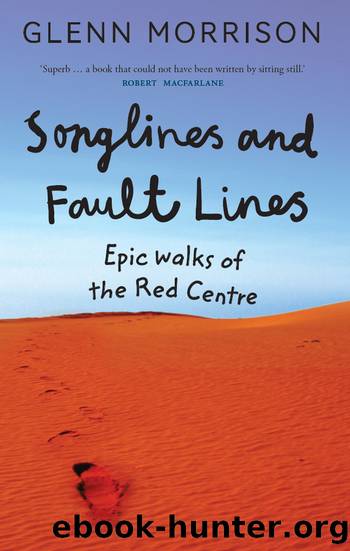Songlines and Fault Lines: Epic Walks of the Red Centre by Glenn Morrison

Author:Glenn Morrison [Morrison, Glenn]
Language: eng
Format: epub
Tags: Travel, Australia & Oceania, Essays & Travelogues, Social Science, Indigenous Studies
ISBN: 9780522870992
Google: sQAvDwAAQBAJ
Publisher: Melbourne University Publishing
Published: 2017-07-31T00:18:48.240522+00:00
Wilderness as an idea is used widely to represent Central Australia today. Eco- and adventure-tourism industries market remote places such as the Larapinta Trail and other routes to hikers, while others ferry tourists to climb or walk around Uluru and stroll Kata Tjutaâs Valley of the Winds.6 Other tourists follow four-wheel drive routes, retracing the steps of the explorers or old stock routes in their vehicle. The image of an Outback destination remains a major strategy of the NT Tourist Commission, with books, newspaper and magazine articles, painting, poetry, films and television all playing their part in shaping the Outback as a holiday destination. American tourists, for example, perceive the Outback as being at an earlier stage of development than the United States, a throwback to their own frontier no longer on show.
While already celebrated by Australian bushwalkers of the early twentieth century, the experience of a journey on foot into âundisturbed natureâ had started to enjoy a broader appeal by mid-century. Such walks were best done âin natureâ, or better still, in âwildernessâ, a term that had co-evolved with Henry David Thoreauâs ideas on the benefits of âwildnessâ, from his proclamation that in âwildness is the preservation of the worldâ.7 Wilderness signified a place where nature was at its purest and the influence of people slight.
First to use the term to describe the Australian landscape was Alexander Sutherland, a Scottish emigrant who arrived in Melbourne in 1870, later establishing The Melbourne Review, a journal of philosophy, culture and politics. Between 1880 and 1882, Sutherland published a series of walking essays in which walking became a conceit to allow the contemplating of issues of the day. Walking was a time for âintelligent discussionâ, to philosophise on the contemporary problems facing society. But Sutherland only felt comfortable with a bush cast as wilderness, a corollary to his work-a-day life in the city. He was happiest camped out in a forest somewhere (he always referred to it as the forest, not the bush) and in the company of cultured companions, where they might truly appreciate the beauty of the bush.
Sutherlandâs depiction of place as salve for the urban soul was a stark contrast to John McDouall Stuartâs, for whom walking was a form of work, a necessary part of conquering and mapping Australia. It was different again from the sensuous writings of the Australian bush by poet John Le Gay Brereton, who, like Thoreau, found communing with nature a transcendental experience. For when he was in the bush, Breretonâs self âmerged with the universeâ.8
From the outset, therefore, wilderness was an urban imagining, hinged upon the difference between city and bush. By the 1920s, such notions had shaped the cultural activity called bushwalking, an activity in which a ârealâ bushwalk meant a walk into the âwildernessâ. In inland Australia, on the other hand, food and water supplies had to be carried, often across great distances, making bushwalking a greater physical commitment than the polite saunter of the Romantic. Perhaps such hardships are what
Download
This site does not store any files on its server. We only index and link to content provided by other sites. Please contact the content providers to delete copyright contents if any and email us, we'll remove relevant links or contents immediately.
Machine Learning at Scale with H2O by Gregory Keys | David Whiting(3653)
Never by Ken Follett(3545)
Liar's Poker by Michael Lewis(3230)
The Ultimate Backcountry Survival Manual by Aram Von Benedikt; Editors of Outdoor Life;(3172)
Will by Will Smith(2589)
The Partner by John Grisham(2286)
Friends, Lovers, and the Big Terrible Thing by Matthew Perry(2012)
Can't Hurt Me: Master Your Mind and Defy the Odds - Clean Edition by David Goggins(2008)
Taste by Kris Bryant(1806)
HBR's 10 Must Reads 2022 by Harvard Business Review(1702)
A Short History of War by Jeremy Black(1677)
Never Finished: Unshackle Your Mind and Win the War Within by David Goggins(1562)
The Arm by Jeff Passan(1527)
515945210 by Unknown(1524)
The Dodgers by Schiavone Michael;(1478)
The Yogi Book by Yogi Berra(1426)
443319537 by Unknown(1400)
A Game of Thrones (The Illustrated Edition) by George R. R. Martin(1374)
1942266391 (N) by Monte Francis(1372)
